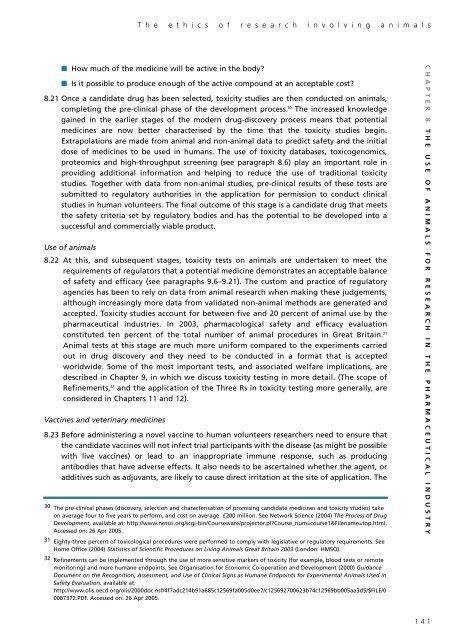The ethics of research involving animals - Nuffield Council on ...
The ethics of research involving animals - Nuffield Council on ...
The ethics of research involving animals - Nuffield Council on ...
You also want an ePaper? Increase the reach of your titles
YUMPU automatically turns print PDFs into web optimized ePapers that Google loves.
T h e e t h i c s o f r e s e a r c h i n v o l v i n g a n i m a l s<br />
■ How much <str<strong>on</strong>g>of</str<strong>on</strong>g> the medicine will be active in the body?<br />
■ Is it possible to produce enough <str<strong>on</strong>g>of</str<strong>on</strong>g> the active compound at an acceptable cost?<br />
8.21 Once a candidate drug has been selected, toxicity studies are then c<strong>on</strong>ducted <strong>on</strong> <str<strong>on</strong>g>animals</str<strong>on</strong>g>,<br />
completing the pre-clinical phase <str<strong>on</strong>g>of</str<strong>on</strong>g> the development process. 30 <str<strong>on</strong>g>The</str<strong>on</strong>g> increased knowledge<br />
gained in the earlier stages <str<strong>on</strong>g>of</str<strong>on</strong>g> the modern drug-discovery process means that potential<br />
medicines are now better characterised by the time that the toxicity studies begin.<br />
Extrapolati<strong>on</strong>s are made from animal and n<strong>on</strong>-animal data to predict safety and the initial<br />
dose <str<strong>on</strong>g>of</str<strong>on</strong>g> medicines to be used in humans. <str<strong>on</strong>g>The</str<strong>on</strong>g> use <str<strong>on</strong>g>of</str<strong>on</strong>g> toxicity databases, toxicogenomics,<br />
proteomics and high-throughput screening (see paragraph 8.6) play an important role in<br />
providing additi<strong>on</strong>al informati<strong>on</strong> and helping to reduce the use <str<strong>on</strong>g>of</str<strong>on</strong>g> traditi<strong>on</strong>al toxicity<br />
studies. Together with data from n<strong>on</strong>-animal studies, pre-clinical results <str<strong>on</strong>g>of</str<strong>on</strong>g> these tests are<br />
submitted to regulatory authorities in the applicati<strong>on</strong> for permissi<strong>on</strong> to c<strong>on</strong>duct clinical<br />
studies in human volunteers. <str<strong>on</strong>g>The</str<strong>on</strong>g> final outcome <str<strong>on</strong>g>of</str<strong>on</strong>g> this stage is a candidate drug that meets<br />
the safety criteria set by regulatory bodies and has the potential to be developed into a<br />
successful and commercially viable product.<br />
Use <str<strong>on</strong>g>of</str<strong>on</strong>g> <str<strong>on</strong>g>animals</str<strong>on</strong>g><br />
8.22 At this, and subsequent stages, toxicity tests <strong>on</strong> <str<strong>on</strong>g>animals</str<strong>on</strong>g> are undertaken to meet the<br />
requirements <str<strong>on</strong>g>of</str<strong>on</strong>g> regulators that a potential medicine dem<strong>on</strong>strates an acceptable balance<br />
<str<strong>on</strong>g>of</str<strong>on</strong>g> safety and efficacy (see paragraphs 9.6–9.21). <str<strong>on</strong>g>The</str<strong>on</strong>g> custom and practice <str<strong>on</strong>g>of</str<strong>on</strong>g> regulatory<br />
agencies has been to rely <strong>on</strong> data from animal <str<strong>on</strong>g>research</str<strong>on</strong>g> when making these judgements,<br />
although increasingly more data from validated n<strong>on</strong>-animal methods are generated and<br />
accepted. Toxicity studies account for between five and 20 percent <str<strong>on</strong>g>of</str<strong>on</strong>g> animal use by the<br />
pharmaceutical industries. In 2003, pharmacological safety and efficacy evaluati<strong>on</strong><br />
c<strong>on</strong>stituted ten percent <str<strong>on</strong>g>of</str<strong>on</strong>g> the total number <str<strong>on</strong>g>of</str<strong>on</strong>g> animal procedures in Great Britain. 31<br />
Animal tests at this stage are much more uniform compared to the experiments carried<br />
out in drug discovery and they need to be c<strong>on</strong>ducted in a format that is accepted<br />
worldwide. Some <str<strong>on</strong>g>of</str<strong>on</strong>g> the most important tests, and associated welfare implicati<strong>on</strong>s, are<br />
described in Chapter 9, in which we discuss toxicity testing in more detail. (<str<strong>on</strong>g>The</str<strong>on</strong>g> scope <str<strong>on</strong>g>of</str<strong>on</strong>g><br />
Refinements, 32 and the applicati<strong>on</strong> <str<strong>on</strong>g>of</str<strong>on</strong>g> the Three Rs in toxicity testing more generally, are<br />
c<strong>on</strong>sidered in Chapters 11 and 12).<br />
Vaccines and veterinary medicines<br />
8.23 Before administering a novel vaccine to human volunteers <str<strong>on</strong>g>research</str<strong>on</strong>g>ers need to ensure that<br />
the candidate vaccines will not infect trial participants with the disease (as might be possible<br />
with live vaccines) or lead to an inappropriate immune resp<strong>on</strong>se, such as producing<br />
antibodies that have adverse effects. It also needs to be ascertained whether the agent, or<br />
additives such as adjuvants, are likely to cause direct irritati<strong>on</strong> at the site <str<strong>on</strong>g>of</str<strong>on</strong>g> applicati<strong>on</strong>. <str<strong>on</strong>g>The</str<strong>on</strong>g><br />
30 <str<strong>on</strong>g>The</str<strong>on</strong>g> pre-clinical phases (discovery, selecti<strong>on</strong> and characterisati<strong>on</strong> <str<strong>on</strong>g>of</str<strong>on</strong>g> promising candidate medicines and toxicity studies) take<br />
<strong>on</strong> average four to five years to perform, and cost <strong>on</strong> average £200 milli<strong>on</strong>. See Network Science (2004) <str<strong>on</strong>g>The</str<strong>on</strong>g> Process <str<strong>on</strong>g>of</str<strong>on</strong>g> Drug<br />
Development, available at: http://www.netsci.org/scgi-bin/Courseware/projector.pl?Course_num=course1&Filename=top.html.<br />
Accessed <strong>on</strong>: 26 Apr 2005.<br />
31 Eighty-three percent <str<strong>on</strong>g>of</str<strong>on</strong>g> toxicological procedures were performed to comply with legislative or regulatory requirements. See<br />
Home Office (2004) Statistics <str<strong>on</strong>g>of</str<strong>on</strong>g> Scientific Procedures <strong>on</strong> Living Animals Great Britain 2003 (L<strong>on</strong>d<strong>on</strong>: HMSO).<br />
32 Refinements can be implemented through the use <str<strong>on</strong>g>of</str<strong>on</strong>g> more sensitive markers <str<strong>on</strong>g>of</str<strong>on</strong>g> toxicity (for example, blood tests or remote<br />
m<strong>on</strong>itoring) and more humane endpoints. See Organisati<strong>on</strong> for Ec<strong>on</strong>omic Co-operati<strong>on</strong> and Development (2000) Guidance<br />
Document <strong>on</strong> the Recogniti<strong>on</strong>, Assessment, and Use <str<strong>on</strong>g>of</str<strong>on</strong>g> Clinical Signs as Humane Endpoints for Experimental Animals Used in<br />
Safety Evaluati<strong>on</strong>, available at:<br />
http://www.olis.oecd.org/olis/2000doc.nsf/4f7adc214b91a685c12569fa005d0ee7/c125692700623b74c12569bb005aa3d5/$FILE/0<br />
0087372.PDF. Accessed <strong>on</strong>: 26 Apr 2005.<br />
CHAPTER 8 THE USE OF ANIMALS FOR RESEARCH IN THE PHARMACEUTICAL INDUSTRY<br />
141
















